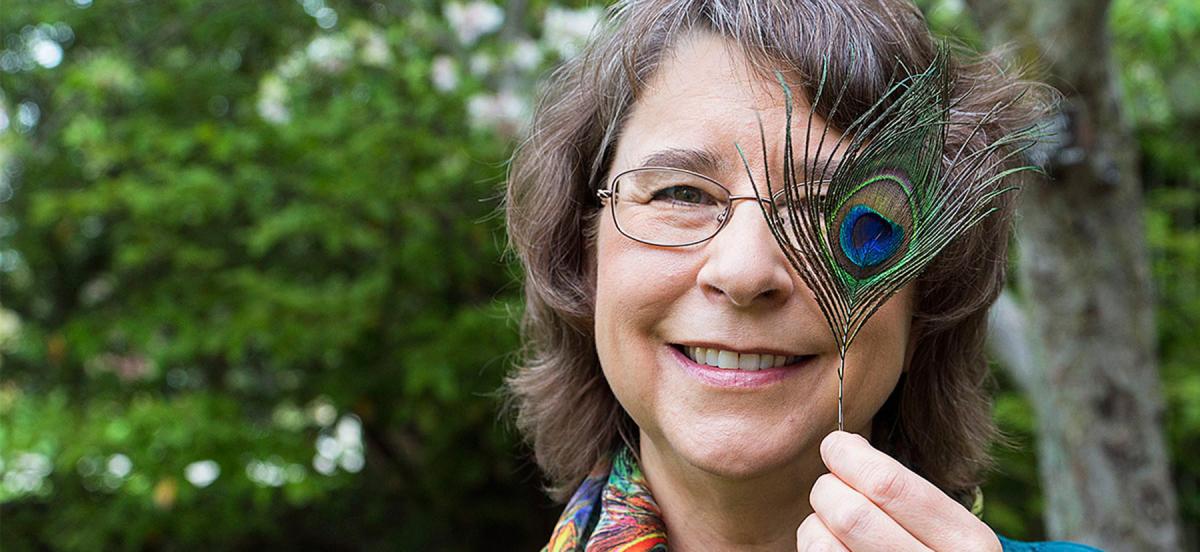Suzanne Amador Kane Co-Authors Study of Peacock Courtship Displays and Feather Biomechanics

Suzanne Amador Kane
Photo by Patrick Montero
Details
The associate professor of physics was part of an interdisciplinary team that determined how dynamic tail vibrations and the mechanical structure of the peacock’s multicolored train enhance the way courting peacocks display to potential mates.
It was a simple YouTube video that led to an international scientific collaboration and discovery. Suzanne Amador Kane, a Haverford associate professor of physics who specializes in biological physics, stumbled upon a high-speed video of a peacock shaking his feathers during a courtship display. Looking at that clip, made by animal behavior researcher Roslyn Dakin of the University of British Columbia in Canada, Kane could see physics properties buried in the display and contacted the Canadian biologist to suggest a collaboration.
"I had just done this work on the falcon cam and the hawk camera work, where I was thinking very much about the way that the prey appears in the predator’s eyes, and the way the predator appears in the prey’s eyes," says Kane, who had previously mounted cameras on falcons and goshawks to study visual guidance in predator pursuit and prey evasion. "So I was thinking about what we call 'visual ecology,' what an animal sees in the context in its whole ecological setting, and I started looking at other dramatic visual displays. When I saw Roz’s videos of the peacock’s display, I was really struck by how another aspect of physics was crying out for study."
Kane reached out to Dakin via social media and the beginnings of a team were born. That team, which also includes Drexel undergraduate Owen McCrossan and biologists James Hare and Robert Montgomerie, just published a paper, "Biomechanics of the Peacock's Display: How Feather Structure and Resonance Influence Multimodal Signaling," in PLOS ONE, the world's first multidisciplinary Open Access journal. The paper explores the "train-rattling" and "wing-shaking" displays of peacock courtship and details the physical properties of their feathers that make the more 150 iridescent eyespots remain nearly stationary during these vibratory demonstrations.
"Charles Darwin observed in 1871 that 'Peacocks … rattle their quills together, and the vibratory movement apparently serves merely to make noise, for it can hardly add to the beauty of their plumage,' but it took this multidisciplinary team of scientists to characterize the dynamics of this behavior," says Kane.
Kane and Dakin spent spring break 2015 at a Los Angeles arboretum filming 14 adult birds using high-speed video. The movements they captured—of vibrating train and tail feathers—and accompanying audio recordings were then analyzed back in the lab. The researchers discovered that peacocks shake their feathers 25 times per second, creating a rattling sound and an iridescent visual display. They also discovered that peacocks drive these vibrations by strumming their tail feathers against the back of their train. Back in the laboratory at Haverford College, measurements and experiments on peacock feathers conducted with McCrossan, a sophomore physics major, established that these feather vibrations are similar to the resonant vibrations of a guitar string.
However, the eyespots at the ends of the vibrating train feathers remain relatively motionless—which surprised Kane since physics predicts that the vibrations to be at a maximum near the end. By using scanning electron microscopy, the research team discovered that this is because the barbs that make up the eyespot are locked together with microhooks much like those on flight feathers, making each eyespot denser than the surrounding loose barbs and keeping it essentially in place as the loose barbs shimmer in the background. This creates a visual effect of eyespots hovering calmly against an oscillating iridescent background—an important effect because iridescence has previously been shown to account for half of peacock mating success.
"Our results suggest that sexual selection—via female choice—may have shaped both the biomechanical design of the eyespot feathers and the behaviors that produce both visual and audio cues," says Montgomerie, a biologist at Queens University. "Darwin thought that the train-rattling sounds could not be an important courtship signal as the males were already the most beautiful of birds. As the fashion industry always tells us, though, it seems that you can never be too beautiful."
"This was an incredibly satisfying project," says Kane, "and it opened up a lot of new questions we can ask next about sexual selection."
-Rebecca Raber
More on this discovery: https://vimeo.com/163411810
Read more about this work in:
- The New York Times
- PBS Newshour
- Scientific American
- Quirks & Quarks (CBC Radio)
- The Christian Science Monitor
- Gizmodo
- Discover magazine
- The Wall Street Journal
- Science News
- Slash Gear
- Two Daily Mail articles
- Phys.org
- The Scientist



